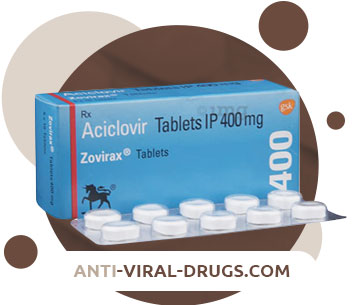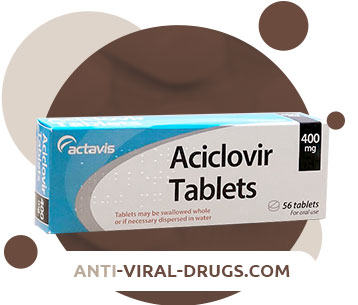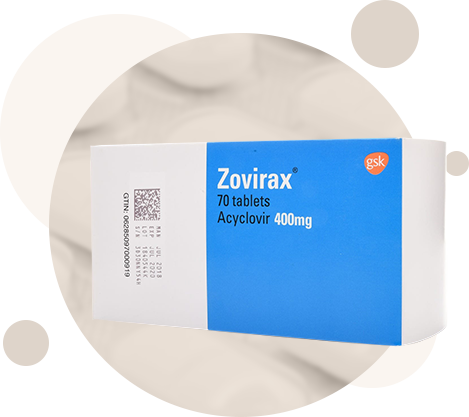
Zovirax
Pharmachologic effect
An antiviral drug, a synthetic analogue of a purine nucleoside, which has the ability to inhibit in vitro and in vivo the replication of Herpes simplex viruses type 1 and 2, Varicella zoster virus, Epstein-Barr virus (EBV) and cytomegalovirus (CMV). In cell culture, acyclovir has the most pronounced antiviral activity against Herpes simplex type 1, then, in decreasing order of activity, follow: Herpes simplex type 2, Varicella zoster, EBV and CMV.
The action of acyclovir on viruses is highly selective. Acyclovir is not a substrate for the enzyme thymidine kinase of uninfected cells, therefore it has low toxicity to mammalian cells. Thymidine kinase of cells infected with Herpes simplex viruses type 1 and 2, Varicella zoster, EBV and CMV converts acyclovir into acyclovir monophosphate - a nucleoside analogue, which is then sequentially converted into diphosphate and triphosphate under the action of cellular enzymes. The incorporation of acyclovir triphosphate into the viral DNA strand and the subsequent termination of the strand blocks further viral DNA replication.
In patients with severe immunodeficiency, prolonged or repeated courses of therapy with acyclovir can lead to the formation of resistant strains, and therefore further treatment with acyclovir may be ineffective. Most of the isolated strains with reduced sensitivity to acyclovir showed a relatively low content of viral thymidine kinase, a violation of the structure of viral thymidine kinase or DNA polymerase. The effect of acyclovir on strains of the Herpes simplex virus in vitro can also lead to the formation of strains that are less sensitive to it. No correlation has been established between the sensitivity of Herpes simplex virus strains to acyclovir in vitro and the clinical efficacy of the drug.

Pharmacokinetics
Suction
When taken orally, acyclovir is only partially absorbed from the intestines. When 200 mg acyclovir was taken every 4 h, the mean plasma CSSmax was 3.1 μmol (0.7 μg / ml), and the average CSSmin was 1.8 μmol (0.4 μg / ml). When 400 mg and 800 mg of acyclovir were taken every 4 hours, CSSmax was 5.3 μmol (1.2 μg / ml) and 8 μmol (1.8 μg / ml), respectively, and the average CSSmin was 2.7 μmol (0.6 μg / ml) and 4 μmol (0.9 μg) / ml), respectively.
Distribution
The concentration of acyclovir in the cerebrospinal fluid is approximately 50% of its plasma concentration. Acyclovir to a small extent (9-33%) binds to blood plasma proteins.
Metabolism and excretion
The main metabolite of acyclovir is 9-carboxymethoxy-methylguanine, which accounts for about 10-15% of the administered dose in the urine.
T1 / 2 is 2.5-3.3 hours. Most of the drug is excreted by the kidneys unchanged. The renal clearance of acyclovir significantly exceeds the clearance of creatinine, which indicates the elimination of acyclovir not only by glomerular filtration, but also by tubular secretion. When acyclovir was prescribed 1 hour after taking 1 g of probenecid, T1 / 2 and AUC increased by 18 and 40%, respectively.
Pharmacokinetics in special clinical situations
In patients with chronic renal failure, T1 / 2 of acyclovir averaged 19.5 hours; when carrying out hemodialysis, respectively, 5.7 hours, and the concentration of acyclovir in plasma decreased by approximately 60%.
In the elderly, acyclovir clearance decreases with age in parallel with a decrease in creatinine clearance, but the T1 / 2 of acyclovir changes insignificantly.
With the simultaneous administration of acyclovir and zidovudine to HIV-infected patients, the pharmacokinetic characteristics of both drugs practically did not change.
Indications
- treatment of infections of the skin and mucous membranes caused by the virus Herpes simplex type 1 and 2, including primary and recurrent genital herpes;
- prevention of recurrence of infections caused by the Herpes simplex virus types 1 and 2 in patients with normal immune status;
- prevention of infections caused by the Herpes simplex virus types 1 and 2 in patients with immunodeficiency;
- treatment of infections caused by the Varicella zoster virus (chickenpox and herpes zoster);
- treatment of patients with severe immunodeficiency, mainly with HIV infection (CD4 + cell count <200 / μl), with early clinical manifestations of HIV infection and with an advanced clinical picture of AIDS) who underwent bone marrow transplantation.
Dosage regimen
For adults, for the treatment of infections caused by the Herpes simplex virus types 1 and 2, the recommended dose of Zovirax is 200 mg 5 times / day every 4 hours (excluding the period of night sleep). Usually, the course of treatment is 5 days, but it can be extended in case of severe primary infections.
In case of severe immunodeficiency (for example, after bone marrow transplantation) or in case of impaired absorption from the intestine, the oral dose of Zovirax may be increased to 400 mg 5 times / day. Treatment should be started as early as possible after the onset of the infection; in case of relapses, the drug is recommended to be prescribed already in the prodromal period or when the first elements of the rash appear.
For the prevention of recurrence of infections caused by the Herpes simplex virus types 1 and 2, in patients with normal immune status, the recommended dose of Zovirax is 200 mg 4 times / day (every 6 hours). A more convenient treatment regimen is suitable for many patients: 400 mg 2 times / day (every 12 hours). In some cases, lower doses of Zovirax are effective: 200 mg 3 times / day (every 8 hours) or 2 times / day (every 12 hours). Treatment with Zovirax should be interrupted periodically for 6-12 months to identify possible changes in the course of the disease.
For the prevention of the occurrence of infections caused by the Herpes simplex virus type 1 and 2, in immunocompromised patients, the recommended dose of Zovirax is 200 mg 4 times / day (every 6 hours). In case of severe immunodeficiency (for example, after bone marrow transplantation) or in case of impaired absorption from the intestine, the oral dose of Zovirax may be increased to 400 mg 5 times / day. The duration of the preventive course of therapy is determined by the duration of the period of existence of the risk of infection.
For the treatment of chickenpox and herpes zoster, the recommended dose of Zovirax is 800 mg 5 times / day, the drug is taken every 4 hours, except for the period of night sleep. The course of treatment is 7 days.
The drug should be prescribed as early as possible after the onset of infection, because in this case, the treatment is more effective.
For the treatment of patients with severe immunodeficiency, the recommended dose of Zovirax is 800 mg 4 times / day (every 6 hours).
Patients who have undergone bone marrow transplantation are usually recommended to undergo a course of intravenous therapy with acyclovir for 1 month before prescribing Zovirax internally. In clinical trials, the maximum duration of treatment for bone marrow transplant recipients was 6 months (from 1 to 7 months after transplantation). In patients with an advanced clinical picture of HIV infection, the course of treatment with Zovirax was 12 months, but there is reason to believe that longer courses of therapy may be effective in such patients.
Treatment and prevention of infections caused by Herpes simplex viruses in immunocompromised children aged 2 years and older - the same doses as for adults; under 2 years of age, half the adult dose.
For the treatment of chickenpox in children over 6 years of age, the drug is prescribed in a single dose of 800 mg; from 2 to 6 years - 400 mg; under 2 years old - 200 mg. The frequency of admission is 4 times / day. More precisely, a single dose can be determined at the rate of 20 mg / kg of body weight (but not more than 800 mg). The course of treatment is 5 days.
There are no data on the use of Zovirax for the prevention of recurrence of infections caused by Herpes simplex viruses and for the treatment of herpes zoster in children with normal immunity indicators.
According to the available very limited information, for the treatment of children over 2 years of age with severe immunodeficiency, the same doses of Zovirax can be used as for the treatment of adults.
When prescribing Zovirax to elderly patients, the possibility of reducing the clearance of acyclovir in parallel with a decrease in the clearance of creatinine should be considered.
If there are signs of renal failure, it is necessary to resolve the issue of reducing the dose of Zovirax. Elderly patients should receive a sufficient amount of fluid while taking Zovirax orally in high doses.
In patients with renal insufficiency, oral acyclovir at recommended doses for the treatment and prevention of infections caused by Herpes simplex viruses does not lead to drug accumulation to concentrations exceeding the established safe levels. However, in patients with CC less than 10 ml / min, the dose of Zovirax is recommended to be reduced to 200 mg 2 times / day (every 12 hours). For the treatment of chickenpox, herpes zoster, as well as for the treatment of patients with severe immunodeficiency with CC less than 10 ml / min, the recommended doses of Zovirax are 800 mg 2 times / day every 12 hours; with CC 10-25 ml / min 800 mg 3 times / day every 8 hours.
Zovirax tablets can be taken with meals, since food intake does not significantly interfere with its absorption. The tablets should be taken with a full glass of water.
Side effects
From the digestive system: nausea, vomiting, diarrhea, abdominal pain; rarely - a reversible increase in the level of bilirubin and the activity of liver enzymes.
From the hematopoietic system: very rarely - anemia, leukopenia, thrombocytopenia.
From the urinary system: rarely - an increase in the level of urea and creatinine in the blood; very rarely - acute renal failure.
From the side of the central nervous system: headache; rarely - reversible neurological disorders, such as dizziness, confusion, hallucinations, drowsiness, convulsions, coma. Usually, these side effects were observed in patients with renal insufficiency who took the drug in doses higher than the recommended ones.
Allergic reactions: rash, photosensitivity, urticaria, itching; rarely - shortness of breath, angioedema, anaphylaxis.
Others: fatigue; rarely - rapid diffuse hair loss. Since this type of alopecia is observed in various diseases and during therapy with many drugs, its connection with the intake of acyclovir has not been established.
In patients receiving antiretroviral drugs, the additional intake of Zovirax did not cause a significant increase in toxic effects.
Contraindications
Hypersensitivity to acyclovir or valacyclovir
It is prescribed with caution for dehydration and renal failure.
Application during pregnancy and lactation
The appointment of Zovirax during pregnancy and lactation (breastfeeding) requires caution and is possible only after assessing the intended benefits to the mother and the potential risk to the fetus and baby.
There was no increase in the number of birth defects in children whose mothers received Zovirax during pregnancy compared to the general population.
After taking Zovirax orally at a dose of 200 mg 5 times / day, acyclovir was determined in breast milk at concentrations of 0.6-4.1% of plasma concentrations. At such concentrations in breast milk, breastfed babies can receive acyclovir at a dose of up to 300 mcg / kg / day.
Special instructions
Patients taking high doses of Zovirax orally should receive sufficient fluid.
Overdose
With an accidental single dose of acyclovir orally in doses up to 20 g, toxic effects have not been recorded.
Symptoms: gastrointestinal disorders (nausea, vomiting) and neurological disorders (headache and confusion); sometimes - shortness of breath, diarrhea, impaired renal function, lethargy, convulsions, coma.
Treatment: careful medical observation in order to identify possible symptoms of intoxication. The use of hemodialysis is possible.
Acyclovir

Pharmacological properties
Pharmacokinetics
The bioavailability of acyclovir when taken 200 mg orally is 15-30%. Food has no significant effect on the absorption of the drug. When prescribing acyclovir orally at a dose of 200 mg 5 times a day, the maximum concentration is 0.7 μg / ml. The connection with plasma proteins is 9-33%. It penetrates well into organs and tissues, including the brain, kidneys, lungs, liver, aqueous humor, lacrimal fluid, intestines, muscles, spleen, breast milk, uterus, mucous membrane and vaginal secretions, semen, amniotic fluid, the contents of herpetic bubbles. Passes through the blood-brain barrier; the concentration in the cerebrospinal fluid is 50% of that in the blood. Penetrates the placental barrier and is excreted in breast milk. It is metabolized in the liver to form 9-carboxymethoxymethylguanine. The half-life is 3.3 hours. It is excreted mainly by the kidneys by glomerular filtration and tubular secretion, with 14% unchanged. Less than 2% of the drug is excreted in the feces.
In the elderly, acyclovir clearance decreases with age in parallel with a decrease in creatinine clearance, but the elimination half-life of acyclovir does not change significantly. In patients with chronic renal failure, the half-life of acyclovir averaged 19.5 hours. During hemodialysis, the mean half-life of acyclovir was 5.7 hours, and the concentration of acyclovir in plasma decreased by approximately 60%.
Pharmacodynamics
Acyclovir is an antiviral drug, a synthetic analogue of the thymidine nucleoside. In infected cells containing viral thymidine kinase, phosphorylation and conversion to acyclovir monophosphate occurs. Under the influence of guanylate cyclase, acyclovir monophosphate is converted into diphosphate and under the action of several cellular enzymes into triphosphate. High selectivity of action and low toxicity to humans are due to the absence of thymidine kinase for the formation of acyclovir triphosphate in intact cells of the macroorganism. Acyclovir triphosphate, integrating into the DNA synthesized by the virus, blocks the multiplication of the virus. The specificity and very high selectivity of action are also due to the predominant accumulation of the drug in the cells affected by the herpes virus. Highly active against viruses Herpes simplex type 1 and 2, Varicella zoster, Epstein-Barr virus. Moderately active against cytomegalovirus. In case of herpes, it prevents the formation of new elements of the rash, reduces the likelihood of cutaneous dissemination and visceral complications, accelerates the formation of crusts, and reduces pain in the acute phase of herpes zoster. It has an immunostimulating effect.
Indications for use
- treatment of herpes infection of the skin and mucous membranes caused by the herpes simplex virus, including primary and recurrent genital herpes, including in patients with impaired immunity
- treatment of infections caused by Varicella zoster viruses (chickenpox and herpes zoster)
- prevention of recurrence of infections caused by the Herpes simplex virus type 1 and 2, Varicella zoster in patients with normal immune status and immunodeficiency
Method of administration and dosage
Acyclovir tablets can be taken with meals, as the meal is does not significantly affect its absorption. The tablets should be taken with a full glass of water.
Adults
Treating herpes simplex virus infections
The recommended dose of Acyclovir is 200 mg (1 tablet) 5 times a day every 4 hours, except at night. Usually the course of treatment is 5 days, but it can be extended for severe primary infections.
In the case of severe immunodeficiency (for example, after bone marrow transplantation) or in case of impaired absorption from the intestine, the dose of Acyclovir can be increased to 400 mg (2 tablets) 5 times a day. Treatment should be started as early as possible after the onset of the infection; in case of relapses, the drug is recommended to be prescribed already in the prodromal period or when the first elements of the rash appear.
Prevention of recurrence of herpes simplex virus infections with normal immune status.
For the prevention of recurrence of infections caused by the herpes simplex virus, the recommended dose of Acyclovir is 200 mg 4 times a day (every 6 hours).
For many patients, a more convenient treatment regimen of 400 mg 2 times a day (every 12 hours) is suitable.
In some cases, lower doses of Acyclovir, 200 mg 3 times a day (every 8 hours) or 2 times a day (every 12 hours), are effective.
In some patients, interruption of infection can occur with a total daily dose of 800 mg.
Treatment with Acyclovir should be interrupted periodically for 6-12 months to identify possible changes in the course of the disease.
Prevention of herpes simplex virus infections in immunocompromised patients
For the prevention of infections caused by the herpes simplex virus in immunocompromised patients, the recommended dose of Acyclovir is 200 mg 4 times a day (every 6 hours).
In the case of severe immunodeficiency (for example, after bone marrow transplantation) or in case of impaired absorption from the intestine, the oral dose of Acyclovir may be increased to 400 mg 5 times a day. The duration of the preventive course of therapy is determined by the duration of the period when there is a risk of infection.
Treatment for chickenpox and herpes zoster
For the treatment of chickenpox and herpes zoster, the recommended dose of Acyclovir is 800 mg (4 tablets) 5 times a day; the drug is taken every 4 hours, except during the night time. The course of treatment is 7 days.
The drug should be prescribed as early as possible after the onset of the infection, as in this case the treatment is more effective.
For the treatment of patients with severe immunodeficiency (for example, after bone marrow transplantation) or in patients with malabsorption from the intestine, intravenous acyclovir is preferable.
Treatment for chickenpox in immunocompetent patients should be initiated within 24 hours of the onset of the rash.
Children
Children under 6 years of age are not recommended to prescribe tablet forms of the drug.
Children over 6 years old
Treating herpes simplex virus infections
200 mg (1 tablet) 5 times a day (every 4 hours), with the exception of the night time. The course of treatment is 5 days.
In the case of severe immunodeficiency (for example, after bone marrow transplantation) or in case of impaired absorption from the intestine, the dose may be increased to 400 mg 5 times a day.
Prevention of herpes simplex virus infections in immunocompromised children
200 mg 4 times a day (every 6 hours).
In the case of severe immunodeficiency - 200 mg 5 times a day.
Chickenpox treatment
800 mg taken 4 times a day.
More precisely, the dose can be determined at the rate of 20 mg / kg of body weight (but not more than 800 mg) 4 times a day. The course of treatment is 5 days.
Prevention of recurrence of herpes simplex virus infections and treatment of herpes zoster in children with normal immunity
No data available.
According to the very limited information available, for the treatment of children over 6 years of age with severe immunodeficiency (CD4 + cell count <200 / mm3, early clinical manifestations of HIV infection and stage of AIDS), the same doses of Acyclovir can be used as for the treatment of adults.
Elderly patients
In old age, there is a decrease in acyclovir clearance in the body in parallel with a decrease in creatinine clearance.
Elderly patients should receive a sufficient amount of fluid while taking high doses of acyclovir orally; in case of renal failure, they need to decide on reducing the dose of acyclovir.
Patients with renal impairment
In patients with renal insufficiency, taking Acyclovir orally at recommended doses for the treatment and prevention of infections caused by the herpes simplex virus does not lead to the accumulation of the drug to concentrations exceeding the established safe levels. However, in patients with severe renal failure (creatinine clearance less than 10 ml / min), it is recommended to reduce the dose of Acyclovir to 200 mg (1 tablet) 2 times a day (every 12 hours).
In the treatment of chickenpox, herpes zoster, as well as in the treatment of patients with severe immunodeficiency, the recommended doses of Acyclovir are:
- severe renal failure (creatinine clearance less than 10 ml / min): 800 mg (4 tablets) 2 times a day every 12 hours;
- moderate renal failure (creatinine clearance 10-25 ml / min): 800 mg (4 tablets) 3 times a day every 8 hours.
Side effects
Very often (> 1/10), often (> 1/100, <1/10), infrequently (> 1/1000, <1/100), rarely (> 1/10000, <1/1000) , very rare (<1/10 000). These side effects are expressed mainly in patients with renal insufficiency.
Often
- headache, dizziness
- nausea, vomiting, diarrhea, abdominal pain
- itching, rash, including photosensitivity
- fast fatigue, fever
Infrequently
- urticaria, rapid diffuse hair loss (the connection with the intake of the drug Acyclovir has not been proven, it is more often associated with multiple variations in the course of the disease and a large number of drugs used)
Rarely
- shortness of breath
- angioedema
- a reversible increase in the level of bilirubin and the activity of liver enzymes
- an increase in the concentration of urea and creatinine in the blood
- anaphylaxis
Very rarely
- anemia, leukopenia, thrombocytopenia
- hepatitis, jaundice
- acute renal failure, renal pain (kidney pain may be associated with renal failure and crystalluria)
- anxiety, confusion, tremor, ataxia, dysarthria, hallucinations, psychotic symptoms, convulsions, drowsiness, encephalopathy, coma (these symptoms are reversible and are usually observed in patients with renal failure or other predisposing factors)
Contraindications
- increased individual sensitivity to acyclovir, valacyclovir, excipients of the drug
- children under 6 years old
Acyclovir should be used with caution in dehydration and renal failure.
Drug interactions
An increase in the effect is noted with the simultaneous appointment of immunostimulants.
There was an increase in the area under the pharmacokinetic curve (AUC) in blood plasma for acyclovir and the inactive metabolite of mycophenolate mofetil, an immunosuppressant used in transplantation, with the simultaneous use of both drugs. However, dose adjustment is not required due to the wide range of therapeutic doses of Acyclovir.
Probenecid reduces the tubular secretion of acyclovir, thereby slowing down its excretion. When acyclovir was prescribed 1 hour after taking 1 g of probenecid, the half-life of acyclovir and the area under the plasma concentration-time curve increased by 18 and 40%, respectively. Acyclovir is excreted unchanged in the urine by active tubular secretion. All drugs with a similar route of elimination can increase the plasma concentration of acyclovir. Cimetidine, being an inhibitor of microsomal oxidation, increases the AUC (area under the plasma concentration-time curve) of acyclovir, decreases its renal clearance and increases plasma concentration. With the simultaneous use of acyclovir with nephrotoxic drugs, the risk of developing nephrotoxic effects increases (especially in patients with impaired renal function). Acyclovir can inhibit theophylline metabolism.
With the simultaneous administration of acyclovir and zidovudine to HIV-infected patients, the pharmacokinetic characteristics of both drugs practically did not change.
Special instructions
When treating genital herpes, sexual intercourse should be avoided, as acyclovir does not prevent sexual transmission of herpes.
During the period of use of the drug, it is necessary to monitor kidney function.
The risk of renal failure increases with the concomitant use of other nephrotoxic drugs.
Patients taking high doses of oral acyclovir should receive sufficient fluids.
Elderly patients and patients with renal insufficiency are at increased risk of developing neurological side effects, these reactions are usually reversible after treatment is stopped. Prolonged or repeated courses of treatment with acyclovir in immunocompromised individuals can lead to the development of viral strains with reduced sensitivity to acyclovir.
Pregnancy and lactation
Analysis of the treatment with Acyclovir in women during pregnancy did not reveal an increase in the number of birth defects in their children compared to the general population.
However, caution should be exercised when prescribing Acyclovir to women during pregnancy and to assess the intended benefit to the mother and the possible risk to the fetus.
After taking Acyclovir orally at a dose of 200 mg (1 tablet) 5 times a day, acyclovir was determined in breast milk at concentrations of 0.6-4.1 of plasma concentrations. At such concentrations in breast milk, children who are breastfed can receive acyclovir at a dose of up to 0.3 mg / kg / day. With this in mind, breastfeeding should be discontinued.
Features of the effect of the drug on the ability to drive a vehicle or potentially dangerous mechanisms
Care should be taken when driving vehicles or other mechanisms.
Overdose
Symptoms: disorders of the gastrointestinal tract (nausea, vomiting), headache, confusion, shortness of breath, diarrhea, impaired renal function, lethargy, convulsions, coma.
Treatment: maintenance of vital functions, hemodialysis.
 DE
DE FR
FR IT
IT ES
ES








